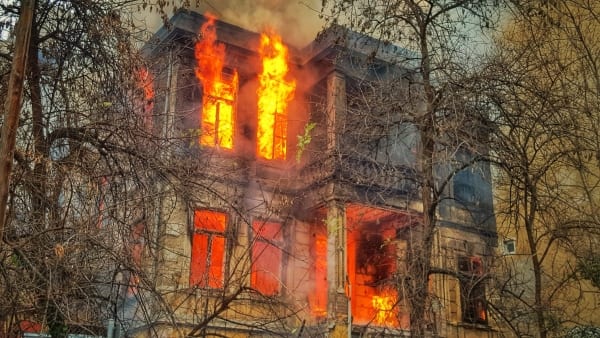The stories are true – the oldest film can burst into flames under the right conditions. Nitrate film sparked the 1937 Fox vault fire and fueled the MGM vault blaze of 1967. These fires were fatal, destructive, and erased huge chunks of U.S. film history in the process.
Although nitrate film was discontinued in the 1950s, it could destroy your whole family legacy if it’s left in your collection. This old film is an extreme fire hazard and gives off harmful gas that can damage other home movies and photos. We’re sharing this post to help you identify nitrate film in your archive and explain the best course of action if you find any.
How Dangerous is Nitrate Film?

Nitrate film is made from cellulose nitrate, a chemical used for military-grade explosives in the late 19th century. It’s so flammable that it even burns underwater, and improper storage makes the fire risk even worse.
Cellulose nitrate releases toxic gas that quickly eats away at any film stored without proper ventilation. Decayed nitrate film is even more volatile, and can self-ignite at temperatures over 100 degrees Fahrenheit. Even if the film doesn’t catch fire, its rapid decay can ruin the images it stores.
If you’re feeling anxious, there’s no need to panic! Most film since the 1950s was made from either polyester or an acetate-based safety film, both of which are less flammable than nitrate. Still, you’ll find information below on how to safely store, handle and even digitize any nitrate film that you find.
Three Stages of Nitrate Film Decay
Some online resources break down the phases of nitrate film decomposition even further, but consider these three main stages for now.
Stage 1: Orange film discoloration and fading images
Stage 2: The film becomes smelly, sticky, and appears bubbly or foamy
Stage 3: The film crumbles into a bad-smelling brownish powder
How to Identify Nitrate Film

It’s not likely that your film stash contains any nitrate film, but it never hurts to check. The National Park Service posted a list of ways to identify nitrate film, and you can look for these signs to find out if you have any:
- Labels: Check to see if the word ‘Nitrate’ is embossed or printed on the edge of the film. Some nitrate films have been copied onto less-flammable safety film, which might have the words ‘Nitrate’ and ‘Safety’ printed on the film.
- Deterioration: If film is in any of the three stages of decay we noted above, assume it’s nitrate. But if the film is wrinkled or smells like vinegar, it’s most likely safety film.
- Dates:
- Assume that any film dated before 1920 is nitrate film.
- Look for notches on the edge of any Kodak film dated from 1921 to 1940. Hold the film with the notches in the upper right corner. If the first notch from the right is shaped like a ‘V,’ you’re holding nitrate film. If the first notch looks like a ‘U,’ it’s most likely safety film.
- For non-Kodak film from 1921 to 1940, all film from 1940 to 1950, and any film that can’t be dated – look for the signs of deterioration we mentioned above.
Remember that differences between manufacturers and storage conditions can vary greatly across different reels of nitrate film. If you’re still not sure what you have, keep reading to find out how to store nitrate film, digitize it, or safely discard it.
Proper Storage of Aging Film

Not ready to discard or digitize your vintage film? You can follow these nitrate film storage standards to minimize the risks of fire and deterioration before you’re ready to act.
- Low temperature: store nitrate film at a constant 50 degrees Fahrenheit
- Low humidity: keep nitrate film at 40-45% relative humidity
- Ventilation: store film in ventilated containers, inside of well-ventilated rooms, to protect nitrate film from the toxic gas it releases over time
- Away from other media: keep your nitrate film separate from other media to minimize the risk of damage from fire and fumes
- Sprinklers: if possible, store your nitrate film under a sprinkler system to keep any potential fires contained
Proper storage is only a temporary solution. Plus, some barriers like cost and space might keep you from installing new air ducts or sprinklers. Read on as you start to think about what you can realistically do with your rare nitrate film.
How to Transport and Digitize
While EverPresent is equipped to digitize nearly all of your aging family memories, nitrate film is one of the few exceptions. Here are some options if you’re ready to convert nitrate film to digital:
- LAC Group
- CinePost
As you consider these nitrate film transfer services, check to see if they also cover transportation and disposal. You can get it shipped by FedEx and discarded by Waste Management, but you should contact them first to let them know what you have. Some extra precautions and handling fees might apply.
Don’t Wait for Too Long

We often write about your photos’ and home movies’ short shelf life, but the risks of this type of film merit a greater sense of urgency. We hope you’re at least ready to store these aging films properly, even if you don’t want to digitize just yet.
Once you’re prepared for a film to digital transfer service, don’t forget to keep us in mind for all of your non-nitrate needs. Feel free to contact us in the meantime with any questions about your vintage movie film. We’re happy to help!

